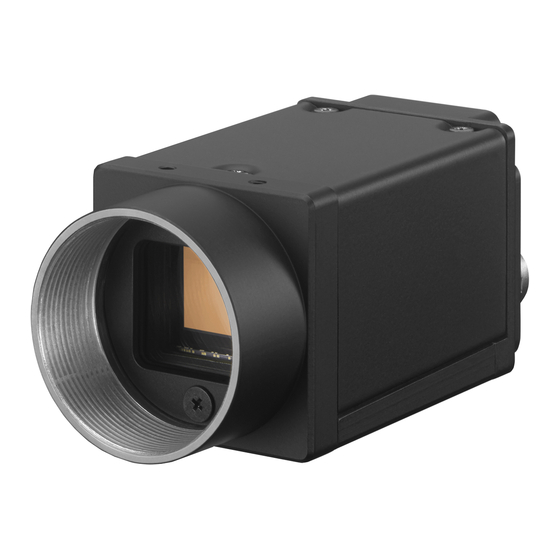Table of Contents
Advertisement
Quick Links
DIGITAL VIDEO CAMERA
Equipped with the Global Shutter Polarization CMOS Sensor
GigE Vision
XCG-CP510
SDK for Polarization Camera (for Windows)
XPL-SDKW
2/3
GigE
Progressive
Type
Vision
Scan
GS CMOS
Long
Long
Image
Normal
Exposure
Exposure
Flip
Shutter
Freeset
Trigger
Partial
Sequence
Scan
range
Outline
XCG-CP510 is innovative camera incorporating the newly
developed 5.1 MP global shutter pixel-level polarization
CMOS sensor.
The On-Chip Polarizer features a four-directional polarizer
formed on the photodiode of the image sensor which allows
the detection of linear angles of polarized light. Combined
with a unique SDK (XPL-SDKW), developed to facilitate
the polarization process, users can easily enable contrast
enhancement, object recognition, scratch detection,
reflection removal, and stress and distortion inspection.
Polarization Camera & SDK for Polarization Camera
■ Polarization Camera XCG-CP510
Capture four directions of the polarization.
Capturing four-pixel block polarized images through linear
polarizing filters (0 deg, 45 deg, 90 deg, 135 deg) without
a parallax issue.
26
XCG-CP510/XPL-SDKW
(B/W)
C
5.1 MP
IEEE
Square
Area
1588
Gain
Pixels
Output
Lens Mount
Bulk
External
Sequential
Auto
4
Trigger
Shutter
Trigger
Trigger
Shutter
B/W
Defect
Defect
Shading
Temperature
Temperature
Correction
Readout
Readout
Correction
Correction
Connection Diagram
Burst
Trigger
PoE
P63
Features
■ Capture a polarized image with one shot
Each individual pixel has one of four different linear
polarization filters which enables four different polarization
images to be captured simultaneously. Each calculation
unit com-posed of four-pixel block supports calculation of
"Polarization directions" and "Degree of Polarization (DoP)"
based on luminance value on each pixel.
■ Feature-rich
The SDK for polarization camera enables the following
polarized image processing.
• Degree of Polarization (DoP)
• Polarization Direction (Surface Normal)
• Reflection Removal n • Reflection Enhancement
• Stress, Distortion (Retardation)
■ Work efficiency
The SDK for polarization camera enables easy polarization
application development. Sony provides a viewer
application, library, and sample source code.
■ SDK for Polarization Camera SDK XPL-SDKW (for Windows)
Process each polarization application by using polarization
signals.
The Windows SDK, provides versatile polarization
functions such as reflection removal, shape recognition,
and stress mea surement by calculating polarization
direction and/or Degree of Polarization (DoP) based on an
image captured by the Po larization camera.
SDK for Polarization
support
XPL-SDKW Configurations
Viewer application
SDK (Library)
XC-SDK (for communication
with the camera)
2020
Advertisement
Table of Contents

Summary of Contents for Sony XCG-CP510
- Page 1 Outline Features ■ Capture a polarized image with one shot XCG-CP510 is innovative camera incorporating the newly Each individual pixel has one of four different linear developed 5.1 MP global shutter pixel-level polarization polarization filters which enables four different polarization CMOS sensor.
-
Page 2: Screen Configuration
FFC processing can be used for post-processing without having to use the polarization camera's shading correction. Screen Configuration <SDK for Polarization Camera XPL-SDKW> * Information on the screen is subject to change without notice 2020 XCG-CP510/XPL-SDKW... -
Page 3: Camera Functions
3 -M3 Depth 3 source variation, are corrected. 16.5 ( 22 ( Unit: mm (inches) XCG-CP510 : 9 patterns ■ Image Flip You can flip the image vertically or horizontally, or rotate it 180 Specifications (SDK for Polarization Camera) degrees. - Page 4 Specifications (Polarization Camera) XCG-CP510 Basic specifications Image type Image size 5.1 MP IMX250 (Polarization image sensor) Image sensor 2/3-type CMOS Image sensors with a global shut ter function (Pregius) Number of effective pixels 2,464 ×2,056 (H × V) Cell size (H × V) 3.45 μm×3.45 μm...
-
Page 5: Spectral Sensitivity Characteristics
Spectral Sensitivity Characteristics • XCG-CP510 (Lens characteristics and light source characteristics excluded.) Relative sensitivity Wavelength (nm) Location and Function of Parts and Controls Rear Panel/Pin Assignments 5 DC IN (DC power input) connector (6-pin) You can connect a camera cable to input the +12 V DC power supply. -
Page 6: Connecting The Cables
0 V to 0.4 V Voltage reading shows figure by terminal with 10 kΩ or more. Note When inputting a trigger signal to the camera using the DC-700/DC- 700CE, use DC 5 V or less at the logical high level. 2020 XCG-CP510/XPL-SDKW... -
Page 7: Trigger Modes
(B) When 2 patterns of exposure times are set the figure. Set the number of exposures, exposure interval (1), and exposure time (2) Continuous shooting at the trigger timing 150 s 80 s Trigger signal Trigger signal 100 s Exposure Exposure Camera output Sensor output 2020 XCG-CP510/XPL-SDKW... -
Page 8: Frame Rate Control
Various signals can be output from the 3rd and 4th DC IN Exposure connector. After selecting a connector by LineSelector register and setting LineMode to Output, LineSource is set. The output Imager readout Cam2 polarity is set by LineInverter register. Camera output 2020 XCG-CP510/XPL-SDKW...









